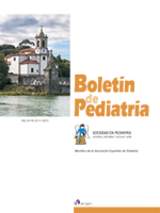¿Son la anemia y la transfusión de glóbulos rojos factores de riesgo para enterocolitis necrotizante en prematuros?
O. Naveda Romero , A. Naveda Meléndez
Bol. Pediatr. 2015; 55 (231): 3 - 9
Introducción: La enterocolitis necrotizante es una emergencia gastrointestinal en prematuros debido a la necrosis transmural del intestino, cuya etiología sigue siendo desconocida. Metodología: Para identificar la asociación entre enterocolitis necrotizante, anemia y transfusión de glóbulos rojos en prematuros menores de 34 semanas de edad gestacional, se realizó un estudio de casos y controles, donde se compararon 45 prematuros con enterocolitis necrotizante estadio II o mayor según criterios de Bell modificados con 90 controles sin enterocolitis necrotizante. Se creó una regresión logística para evaluar el efecto sobre el riesgo. Resultados: A través de una regresión logística multivariable, controlando Apgar al 5° minuto, sepsis, síndrome de dificultad respiratoria, alimentación completa, SNAP-PE II como factores de confusión, se identificó que la presencia de hematocrito menor de 30% incrementa el riesgo de enterocolitis necrotizante en prematuros menores de 34 semanas (OR: 1,5; 95% IC 1,0-9,5; p = 0,01); además, el riesgo de enterocolitis necrotizante se incrementó en 2,1 veces (95% IC 1,7-6,4; p = 0,04) con transfusión de glóbulos rojos en las 48 horas previas al diagnóstico. El grupo control recibió 1 ± 1 transfusiones y el grupo con enterocolitis necrotizante recibió 3 ± 1 transfusiones de glóbulos rojos antes del diagnóstico (OR: 3,2; 95% IC 2,3-8,6; p < 0,01). Conclusión: La anemia puede incrementar el riesgo de desarrollo de enterocolitis necrotizante en prematuros,este riesgo se incrementa significativamente en las 48 horas posteriores a la transfusión y después de un aumento en la frecuencia de transfusiones de glóbulos rojos.
Are anemia and red blood cell transfusion risk factors for necrotizing enterocolitis in premature infants?
Introduction. Necrotizing enterocolitis is an emergency gastrointestinal disease in neonates due to transmural necrosis of the bowel, whose etiology remains unknown.
Methodology. To determine association of anemia and ed blood cell transfusions with necrotizing enterocolitis in reterm infants, a study of cases and controls was designed, ere compared 45 infants with necrotizing enterocolitis tage II or greater than stage II on the modified Bell’s criteria ith 90 controls without necrotizing enterocolitis. A ogistic regression model was created to evaluate the effect n the risk of necrotizing enterocolitis.
Results. Through multivariate logistic regression corrected or Apgar score at 5° minute, sepsis, respiratory difficulty yndrome, full feeds achieved, SNAP-PE II as confounding actors, was identified the presence of hematocrit ess than 30% increased risk of necrotizing enterocolitis in nfants less than 34 weeks (OR: 1.5; 95% CI 1.0-9.5, p = 0.01); lso, the risk of necrotizing enterocolitis increased 2.1 times 95% CI 1.7-6.4, p = 0.04) with transfusion 48 hours before the necrotizing enterocolitis diagnosis. The control group received 1 ± 1 transfusions, and the necrotizing enterocolitis roup received 3 ± 1 red blood cell transfusions before the ecrotizing enterocolitis diagnosis (OR: 3.2; 95% CI 2.3-8.6, < 0.01).
Conclusion. Anemia may increase the risk of developing ecrotizing enterocolitis in preterm infants. The risk or necrotizing enterocolitis increased significantly with ncreased transfusion frequency before the necrotizing enterocolitis iagnosis or during the 48 hours after red blood cell ransfusion.
Artículo completo (PDF) (482 kb.)
- Neonatología
